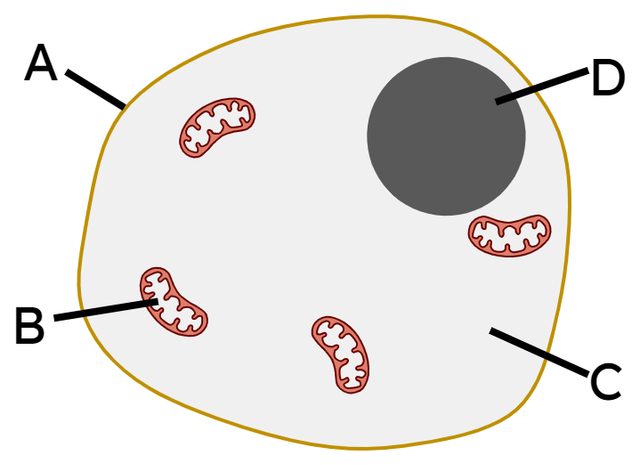Starter quiz
 All animals are made up of tiny living building blocks called ______.
All animals are made up of tiny living building blocks called ______.- 'cells' ✓
- Which organisms are made up of cells?
- only animals
- only animals and plants
- only animals, plants and fungi
- all organisms ✓
-
 What is the name of the structure labelled A in the diagram of an animal cell?
What is the name of the structure labelled A in the diagram of an animal cell?- 'cell membrane' ✓
- Which diagram best represents the particles that make up the cell cytoplasm?
 diagram A
diagram A diagram B ✓
diagram B ✓ diagram C
diagram C
 The particles of oxygen will move through the cell cytoplasm due to the process of ...
The particles of oxygen will move through the cell cytoplasm due to the process of ...- concentration.
- diffusion. ✓
- gradient.
- solution.
-
- Which diagram is labelled correctly?
 diagram A: net movement is up a concentration gradient from low to high
diagram A: net movement is up a concentration gradient from low to high diagram B: net movement is down a concentration gradient from high to low ✓
diagram B: net movement is down a concentration gradient from high to low ✓ diagram C: net movement is against a concentration gradient from low to high
diagram C: net movement is against a concentration gradient from low to high diagram D: no concentration gradient and no net movement
diagram D: no concentration gradient and no net movement
Exit quiz
 Which of these are features of the cell membrane?
Which of these are features of the cell membrane?- controls what can enter and leave the cell ✓
- is where cellular respiration takes place
- is where substances are stored
- makes the cell’s food
- surrounds the cell cytoplasm ✓
-
 Which statement about the cell membrane is true?
Which statement about the cell membrane is true?- It has no holes in it.
- It has large holes in it.
- It has small holes in it. ✓
-
 Who has the correct idea about the cell membrane?
Who has the correct idea about the cell membrane? Aisha: “Particles of all substances can move through the holes in the membrane.”
Aisha: “Particles of all substances can move through the holes in the membrane.” Alex: “Only large particles can move through the holes in the membrane.”
Alex: “Only large particles can move through the holes in the membrane.” Jacob: “Only small particles can move through the holes in the membrane.” ✓
Jacob: “Only small particles can move through the holes in the membrane.” ✓ Sofia: “No particles can move through the holes in the membrane.”
Sofia: “No particles can move through the holes in the membrane.”
 Which type of particle will not move through the holes in the cell membrane?
Which type of particle will not move through the holes in the cell membrane?- particle A
- particle B
- particle C ✓
-
- The cell membrane is described as a ______-permeable membrane.
- 'selectively' ✓
 Which statement is true?
Which statement is true?- Net movement of particles of carbon dioxide will be from the inside to outside. ✓
- Particles of carbon dioxide cannot diffuse through the cell membrane.
- Particles of carbon dioxide will diffuse up the concentration gradient.
- The concentration of particles of carbon dioxide is higher outside the cell.
- There is no concentration gradient across the cell membrane.
-
Worksheet
Presentation
Video
Lesson Details
Key learning points
- All substances, including the cell cytoplasm and substances within it, are made up of particles.
- Particles of some substances diffuse into and out of a cell by moving through small holes in the cell membrane.
- The particles that make up some substances are too big to diffuse through the holes in the cell membrane.
- The cell membrane is selectively-permeable because only some substances can diffuse through it.
- The net movement of particles through a cell membrane is down a concentration gradient.
Common misconception
Thinking that all, or no, substances can diffuse through the cell membrane. Thinking that cells choose to take in particular substances, or that cells breathe or suck in substances such as oxygen.
The lesson explores the idea that particles of some, but not all, substances are small enough to diffuse through holes in the selectively-permeable cell membrane.
Keywords
Cell membrane - All cells are surrounded by a membrane that controls what can enter and leave the cell.
Particles - All substances are made up of particles that are too small for us to see.
Diffusion - Diffusion is the net movement of particles of a substance down a concentration gradient.
Selectively-permeable - A material is selectively-permeable if some substances can move through it but others cannot.
Net movement - Net movement is the overall movement of particles from one area to another.